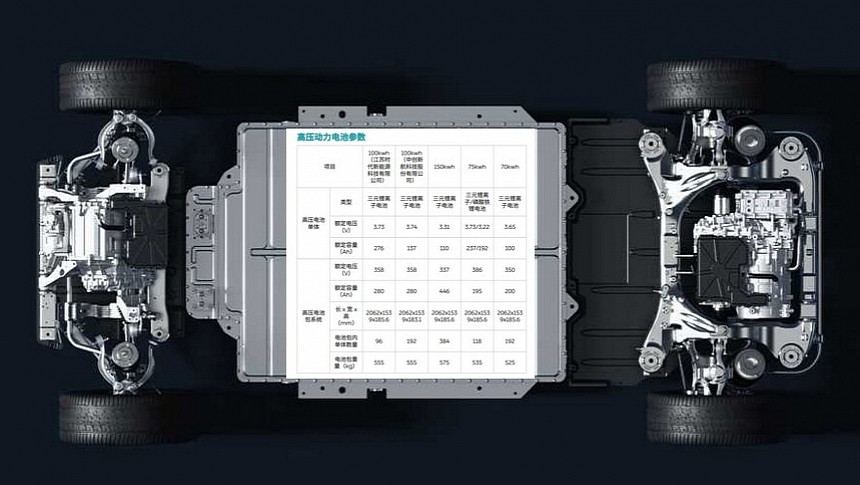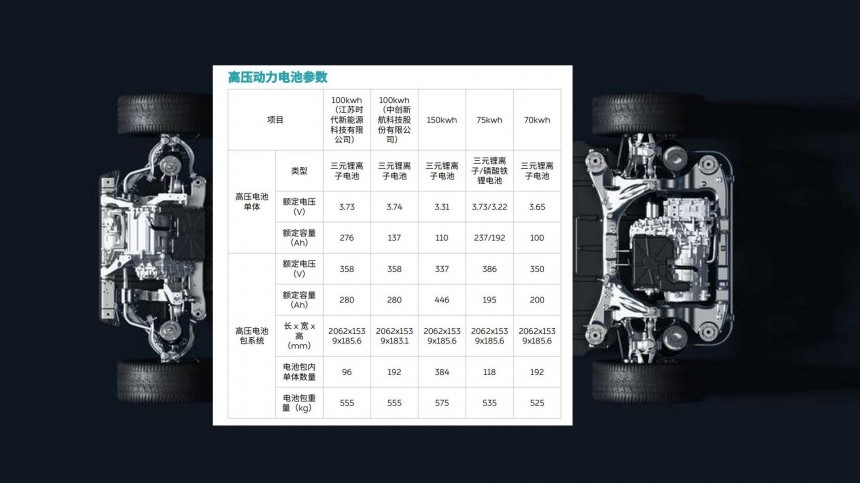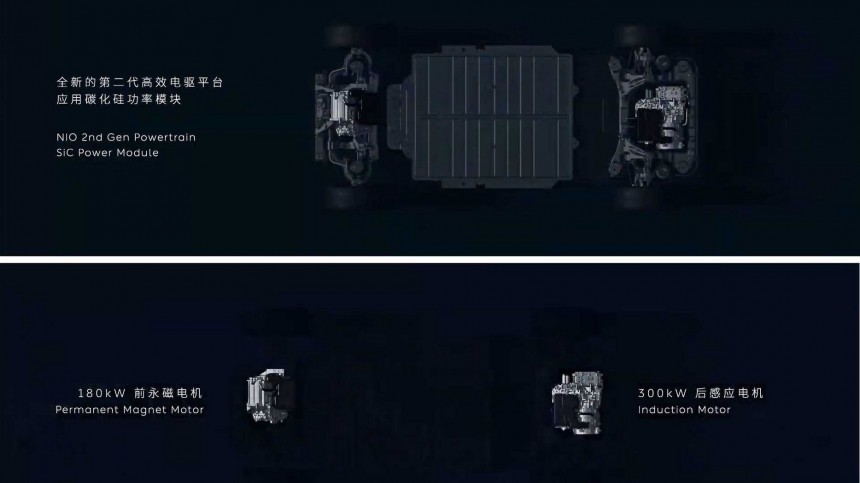At the 2020 NIO Day – which was held in January 2021 – William Li said the ET7 would have a solid-state battery pack in 2022. Since then, we discovered that the cells would be made by Solid State Lion – a company that is now called WeLion – and that they were actually semi-solid-state batteries. Like other BEV maker's CEOs, Li failed to get the company's schedule right, but the owner's manuals of its cars show he and his automaker are getting closer to revealing the new component.
According to CNEVPost, the 150-kWh battery pack will weigh 575 kilograms (1,267.7 pounds) with 384 units of the new cells. That makes its energy density reach 260.9 Wh/kg. NIO's previous largest battery pack option offered 100 kWh in a pack that tipped the scale at 555 kg (1,223.6 lb) with 96 cells. Do the math, and you'll see its energy density is 180.2 Wh/kg. It is impressive that the 150-kWh battery pack weighs only 20 kg (44.1 lb) more than the one with 100 kWh. That presents 50% more energy with a mere 3.6% mass increase.
The explanation for that is that the WeLion cells present the highest energy density of any battery currently for sale: 360 Wh/kg. The energy density difference at cell and battery pack levels shows how much the structural elements of a battery pack penalize electric cars. At the same time, they may be necessary to make these components easier to repair, which certainly puts carmakers worried about that at crossroads: they will have to choose between repairability and energy density. Controversies aside, 260.9 Wh/kg is what some of the best lithium-ion cells present before being gathered together in a battery pack.
Compare that with what Tesla offers in a Model S. Thanks to Second Life EV Batteries, we know that the 103-kWh battery pack weighs 615 kg, which may be explained by the 8,256 cells distributed into 16 modules. Ironically, these modules do not make the Model S's battery pack easier to repair. The 18650 batteries are not particularly energy-dense as well, which only worsens the situation. The Model S battery pack has an energy density of only 167.5 Wh/kg. If you consider the Model 3, it offers 74 kWh and tips the scale at 479 kg (1,056 lb), which translates into an energy density of just 154.5 Wh/kg. Using this example, NIO's battery pack has twice as much energy as the one Tesla installs on the Model 3 for a difference of less than 100 kg (220.5 lb) – 96 kg (211.6 lb), to be more precise.
On top of being able to carry more energy than any of its competitors, the 150-kWh high-voltage accumulator is also swappable. NIO's customers pay for Battery-as-a-Service (BaaS) and replace the battery packs whenever they want. That is a pretty convenient solution for BEV owners who can't charge their cars at home. It is also extremely handy on road trips. That even masks a shortcoming these battery packs have: a voltage of 337V.
In the STLA Medium platform from Stellantis, that is a problem: it reduces the speed at which the vehicles can fast charge. If they worked at 800V, fast charging times would be significantly reduced. Any vehicle underpinned by the new Stellantis platform will take 27 minutes to charge from 20% to 80% of capacity. For NIO vehicles, swapping a depleted battery pack with one delivering 150 kWh will take less than five minutes.
A recent video from China showed a Geely Cao Cao 60 losing its swappable battery pack in the middle of a street. Instead of being the nail in the coffin of this technology that its detractors thought it would, it just showed that NIO is ahead of the competition in battery swapping. There is not a single event that is remotely similar involving NIO vehicles – at least that we have heard of. Although stuff that happens in China eventually turns into world news, most of what happens there dies there. With NIO in Europe, we should know about any issues with battery swapping in no time should they occur.
NIO's owner's manual also disclosed interesting information about other battery packs from the company. The 75-kWh unit with LFP and ternary cells weighs 535 kg (1,179.5 ib) and counts on 118 batteries, while the remaining 70-kWh units are lighter still: 525 kg (1,157.4 lb) and 192 cells. There is also a new 100-kWh battery pack, which uses 192 batteries supplied by CALB, another sizeable Chinese cell maker. The initial 100-kWh battery pack had CATL cells – 96 of them, to be exact.
As soon as these 150-kWh battery packs reach their first customers, we will have to pay attention to how they behave. NIO said vehicles with the new component may travel up to 1,000 km (621 miles). Such a range may even make battery swapping unnecessary, even if desirable. Anyone who has ever experienced range anxiety or was in a rush to travel anywhere will praise the convenience of this system – as well as the lower price for a vehicle that does not come with a battery pack. As long as defective or damaged components do not catch fire at the stations storing them, everything should be fine.
The explanation for that is that the WeLion cells present the highest energy density of any battery currently for sale: 360 Wh/kg. The energy density difference at cell and battery pack levels shows how much the structural elements of a battery pack penalize electric cars. At the same time, they may be necessary to make these components easier to repair, which certainly puts carmakers worried about that at crossroads: they will have to choose between repairability and energy density. Controversies aside, 260.9 Wh/kg is what some of the best lithium-ion cells present before being gathered together in a battery pack.
Compare that with what Tesla offers in a Model S. Thanks to Second Life EV Batteries, we know that the 103-kWh battery pack weighs 615 kg, which may be explained by the 8,256 cells distributed into 16 modules. Ironically, these modules do not make the Model S's battery pack easier to repair. The 18650 batteries are not particularly energy-dense as well, which only worsens the situation. The Model S battery pack has an energy density of only 167.5 Wh/kg. If you consider the Model 3, it offers 74 kWh and tips the scale at 479 kg (1,056 lb), which translates into an energy density of just 154.5 Wh/kg. Using this example, NIO's battery pack has twice as much energy as the one Tesla installs on the Model 3 for a difference of less than 100 kg (220.5 lb) – 96 kg (211.6 lb), to be more precise.
In the STLA Medium platform from Stellantis, that is a problem: it reduces the speed at which the vehicles can fast charge. If they worked at 800V, fast charging times would be significantly reduced. Any vehicle underpinned by the new Stellantis platform will take 27 minutes to charge from 20% to 80% of capacity. For NIO vehicles, swapping a depleted battery pack with one delivering 150 kWh will take less than five minutes.
A recent video from China showed a Geely Cao Cao 60 losing its swappable battery pack in the middle of a street. Instead of being the nail in the coffin of this technology that its detractors thought it would, it just showed that NIO is ahead of the competition in battery swapping. There is not a single event that is remotely similar involving NIO vehicles – at least that we have heard of. Although stuff that happens in China eventually turns into world news, most of what happens there dies there. With NIO in Europe, we should know about any issues with battery swapping in no time should they occur.
As soon as these 150-kWh battery packs reach their first customers, we will have to pay attention to how they behave. NIO said vehicles with the new component may travel up to 1,000 km (621 miles). Such a range may even make battery swapping unnecessary, even if desirable. Anyone who has ever experienced range anxiety or was in a rush to travel anywhere will praise the convenience of this system – as well as the lower price for a vehicle that does not come with a battery pack. As long as defective or damaged components do not catch fire at the stations storing them, everything should be fine.














